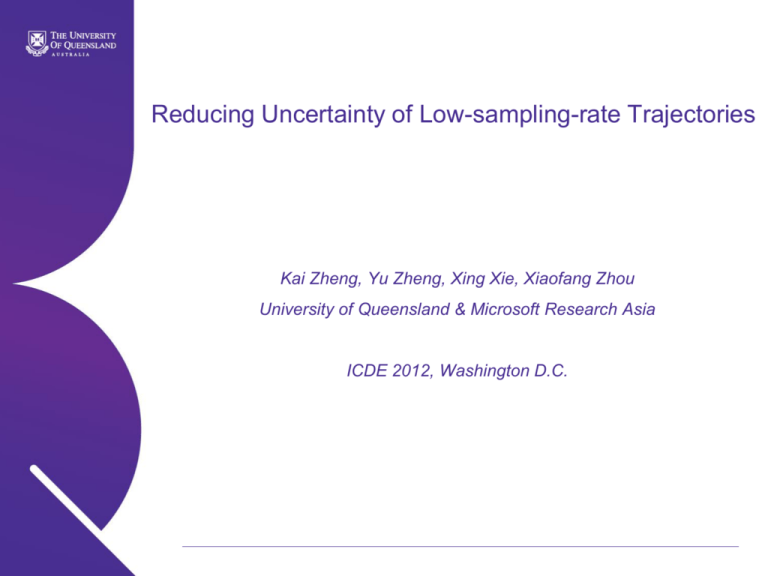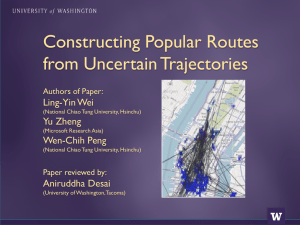ICDE12 - Microsoft Research
advertisement

Reducing Uncertainty of Low-sampling-rate Trajectories Kai Zheng, Yu Zheng, Xing Xie, Xiaofang Zhou University of Queensland & Microsoft Research Asia ICDE 2012, Washington D.C. Outline • Introduction • Problem • Methodologies • Evaluation Trajectories in mathematical and real worlds • A location trajectory is a record of the path of a variety of moving objects, such as people, vehicles, animals and nature phenomena • From mathematics point, a trajectory is a continuous mapping from time to space • In real world, GPS devices can only report their locations on discrete time instants. • Essentially, a real world trajectory is a sample of its counterpart in mathematical world. Trajectories in mathematical and real worlds Low-sampling-rate Issues • Since we always use a sample to approximate the original trajectory of the moving object, higher sampling rate results in better approximation • However, huge amount of low-sampling-rate trajectories exist in many scenarios Low-sampling-rate Issues (Cont.) • GPS devices report their location at low frequency to save battery and communication cost Less than 17% of trajectories with sampling rate > every 2 mins, based on 30000+ taxicabs of Beijing • Tourists can upload their photos with geo-tags to photo sharing services (Flickr etc), which also form trajectories of their travel routes Impact of low-sampling-rate • Detailed travel information is lost • Uncertainty arise when querying against such kind of data • Making decision solely based on these data can be unhelpful (e.g. traffic management, urban planning) Traditional methodologies • Just ignore this issue, and process as usual • Uncertainty-awareness trajectory models, indexes, and queries Space-time prism model, necklace model Probabilistic queries (range and NN) Our idea • Can we reduce the uncertainty caused by the lowsampling-rate before the trajectories undergo further processing? • To be more specific, can we estimate its original route from the samples? • Our basic idea is to leverage the historical trajectory data as well as the following two observations. Key Observation – 1 • Travel patterns between certain locations are often highly skewed • we can find some popular routes between certain locations • Limitation: we need a reasonably large set of quality trajectories with high-sampling-rate, so that we can know their routes A C B Key Observation – 2 • Trajectories sharing the same/similar routes can often complement each other to make themselves more complete • In other words, it’s possible to interpolate a low-sampling-rate trajectory by cross-referring other trajectories on the same/similar route, so that they all become high-samplingrate Challenges on real data • Data sparseness Trajectories are sparse compared with the space A query can be given with any origin and destination, which may not exist in historical dataset • Data quality The trajectory dataset is mixed with high- and low-sampling-rate trajectories GPS locations can be off-road (in most case they are!) Outlier Outline • Introduction • Problem • Methodologies • Evaluation Problem statement • Input A set of historical trajectories (various qualities) A road network A user-given query trajectory with low-sampling-rate • Output A few possible routes of this query trajectory Main contributions • Propose a new idea and framework on how to deal with low-sampling-rate trajectories • Develop a system based on real-world large trajectory dataset Trajectories of taxicabs in Beijing Outline • Introduction • Problem • Methodologies • Evaluation System Overview Outline • Introduction • Problem • Methodologies • Pre-processing • Reference trajectory search • Local route inference • Global route inference • Evaluation Preprocessing (on historical data) • Trip partition A GPS log contains the record of movement for a long period Partition a long trajectory into meaningful trips Concept: stay point [zheng2009mining] • Map matching for GPS points Candidate edges • Indexing all the GPS points A Stay Point S Latitude, Longitude, Time p1: Lat1, Lngt1, T1 p2: Lat2, Lngt2, T2 ………... pn: Latn, Lngtn, p1 p6 p3 p7 p2 Tn p4 p5 Route inference • Search for reference trajectories Select the relevant historical trajectories that may be helpful in inferring the route of the query • Local route inference Inferring the routes between consecutive samples of query • Global route inference Inferring the whole routes by connecting the local routes Outline • Introduction • Problem • Methodologies • Pre-processing • Reference trajectory search • Local route inference • Global route inference • Evaluation Reference trajectory search • Intuitively, we only need to utilize the ones in the surrounding area of the query since the relationship between two trajectories faraway from each other is usually • Simple and spliced reference trajectory Reference trajectory search (cont.) • Simple reference trajectory • They natively exist in the trajectory archive Reference trajectory search (cont.) • T1, T2 -- yes • T3, T4 – no Reference trajectory search (cont.) • Spliced reference trajectory • They don’t exist in the trajectory archive by nature • Formed by splicing two parts of trajectories Reference trajectory search (cont.) • T1, T2, T4 – not simple reference trajectory • Parts of T1 and T2 can form a reference trajectory Reference trajectory search (cont.) • Why we only consider two consecutive points? • Why we propose spliced reference trajectory? Data sparseness! Outline • Introduction • Problem • Methodologies • Pre-processing • Reference trajectory search • Local route inference • Global route inference • Evaluation Local route inference • Basic idea is to treat all the reference trajectories collectively • Using the points from reference trajectories as the evidence of popularity of each road • Traverse graph based approach • Nearest neighbor based approach Traverse graph based approach • Intuition: if a road segment is not travelled by any reference, there is a high chance that the query object did not pass by it either • Focus on the road segments traversed by some reference trajectories rather than all the edges in the road network Traverse graph based approach (cont.) Essentially, the traverse graph is a conceptual graph that incorporates the topological structure of the underlying road network as well as the distribution of reference trajectories Traverse graph based approach (cont.) Traverse graph based approach (cont.) 𝜆=2 • Graph reduction: remove the redundant edges of the graph (e.g., 𝑟3 → 𝑟5 is redundant, 𝑟4 → 𝑟2 is not) • Use the k shortest paths of this graph as the candidate local possible route of the query Traverse graph based approach (cont.) • Pros: inference is more reliable • Cons: 𝜆 is hard to specify when only a small amount of reference trajectories are available Too low: low connectivity in the traverse graph Too high: graph construction is not efficient Nearest neighbor based approach • Consider all the reference points in Euclidean space • Try to find a continuous hops with shortest Euclidean distance from origin to destination via the reference points • Recursively search for kNN of the current position and jump to one of the kNNs Nearest neighbor based approach (cont.) Nearest neighbor based approach (cont.) • We will keep track of each path that has been built. So if another recursion hits any node of this path, we can re-use them Nearest neighbor based approach (cont.) • Pros: more adaptive to the distribution of the reference trajectories • Cons: not as reliable as the traverse graph not efficient when the number of reference points increase Hybrid approach • Combine the advantage of both approaches • Detect the density of reference points in surrounding area • High density: traverse graph based • Low density: nearest neighbor based Outline • Introduction • Problem • Methodologies • Pre-processing • Reference trajectory search • Local route inference • Global route inference • Evaluation Global route inference • Connect the candidate local routes between consecutive samples to form the global route, which is the final answer to the query • Answer will be useless if we simply return all the combinations of the local route k local routes for each segment, with 10 segments 𝑘10 combinations! • Select a small subset of them to output Which subset??? Global route inference (cont.) • Connect the candidate local routes between consecutive samples to form the global route, which is the final answer to the query • Answer will be useless if we simply return all the combinations of the local route k local routes for each segment, with 10 segments 𝑘10 combinations! • Select a small subset of them to output Which subset??? Global route inference (cont.) • The quality of a global route depends on • The quality of each local route • The quality of the connections between local routes • Correspondingly, • popularity function for each local route • transition confidence function for the connections Global route inference (cont.) • Popularity of a local route • How many traffic on the route • The distribution of the traffic on each road of the route 𝑅𝑎 is preferred since there is smooth traffic flow, burst traffic in 𝑅𝑏 can be caused by a road intersection, in which many vehicles just cross 𝑅𝑏 rathe than travelling on it Global route inference (cont.) • Popularity of a local route 𝑅: 𝑟1 , 𝑟2 , … , 𝑟𝑛 𝐶𝑖 𝑟 is the set of reference trajectories 𝑥 𝑟 is the percentage of the reference trajectories on r Global route inference (cont.) • Route transition confidence of the connection between local routes 𝑅𝑎 and 𝑅𝑏 • The more common trajectories shared by two local routes, the higher score they will get 𝑔 𝑅𝑎 , 𝑅𝑏 = 𝑒𝑥𝑝 𝐶 𝑅𝑎 ∩ 𝐶(𝑅𝑏 ) −1 𝐶 𝑅𝑎 ∪ 𝐶(𝑅𝑏 ) Global route inference (cont.) • Global route score for 𝑅: 𝑅1 ⋄ 𝑅2 ⋄ 𝑅3 … ⋄ 𝑅𝑛 Global route inference (cont.) • We try to find the subset of global routes that maximize the global route score • Downward closure property holds: an optimal route implies an optimal sub-route • Can be solved by Dynamic Programming method Outline • Introduction • Problem • Methodologies • Evaluation Experiment setup • Historical dataset: 100K raw trajectories of 33,000+ Beijing taxicabs over 3 months as the historical trajectory set (about 10% have at least one sample point in every 2 minutes) • Beijing digital map with 106,579 road nodes and 141,380 road segments • Query trajectories are from Geolife project Evaluation approach • Ground truth: query trajectories from Geolife are of highsampling-rate, so we know their original routes • We re-sample the queries using low-sampling-rate as the input of our system for test purpose • Compare the route recovered by our methods against the original one Evaluation approach • As comparison, we use three map-matching algorithm to align the samples onto the road and interpolate by shortest path • Incremental method [Greenfeld2002matching] • ST-matching [lou2009map] • IVMM algorithm [yuan2010interactive] Results summary Accuracy w.r.t. sampling rate (sample/minute) Results summary (cont.) Accuracy w.r.t. query length Results summary (cont.) Effect of search radius for reference trajectories Results summary (cont.) Effect of density of reference points (#𝑝𝑜𝑖𝑛𝑡/𝑘𝑚2) Results summary (cont.) Effect of 𝜆 in traverse graph construction Conclusion and future work • Adopt a new perspective to deal with the data quality issue in real trajectory base • Develop a systematic framework based on real historical taxi data to demonstrate the feasibility of our proposals • We haven’t considered personalization so far, which may be another interesting direction • It may be helpful to incorporate more environmental factors into the system, such as the weather, time, real-time traffic condition, etc. Thank you & welcome to Brisbane for ICDE’13!





